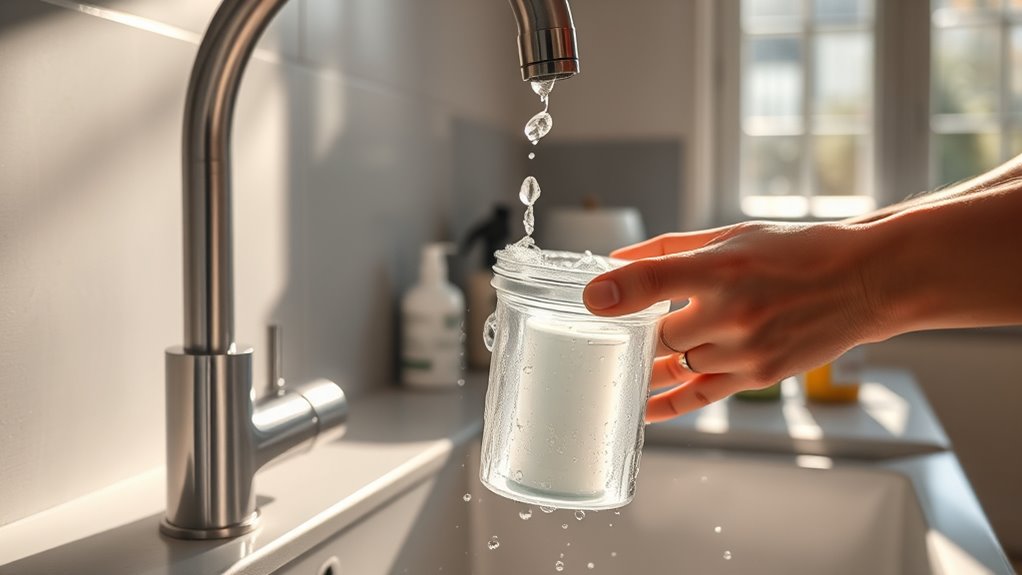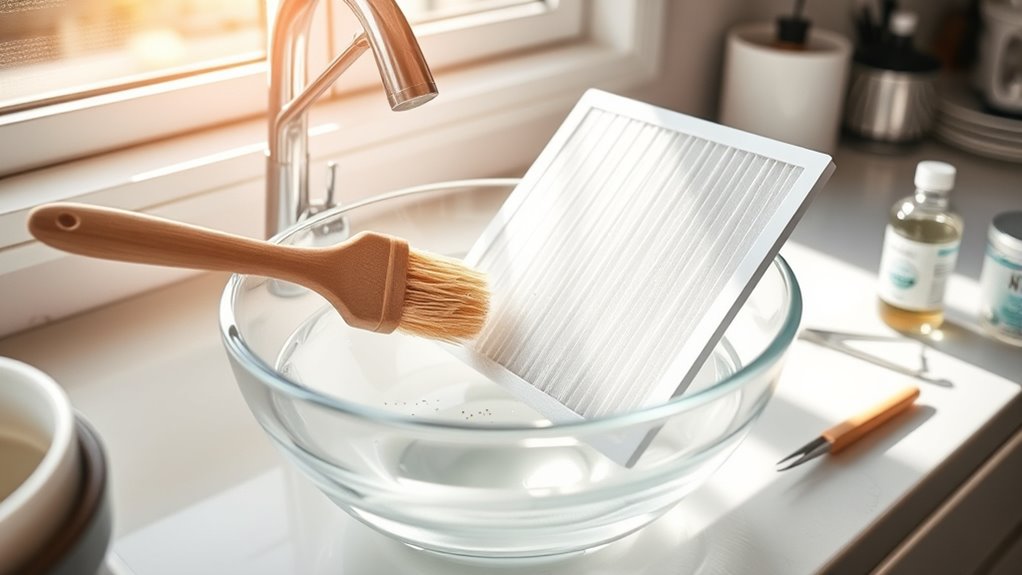To improve filter rinsing on a budget, use a spray nozzle with adjustable water pressure to control flow and avoid damage. Rinse filters under cold, running water gently without harsh scrubbing. Schedule regular maintenance to prevent buildup and extend filter life. Soak filters in vinegar to remove mineral deposits without costly cleaners. Keeping filters clean and using simple tools can save money while maintaining peak performance—stay tuned for more practical tips to get the most from your filters.
Key Takeaways
- Use an adjustable spray nozzle to control water pressure and prevent filter damage without extra cost.
- Rinse filters under cold, running water regularly to extend lifespan and reduce replacement expenses.
- Soak filters in vinegar solution periodically to remove mineral buildup, saving money on replacements.
- Schedule routine rinsing to prevent dirt buildup and avoid costly deep cleaning or filter replacements.
- Avoid hot water and harsh brushes, using gentle techniques to maintain filter integrity and reduce repair costs.
Effective and Budget-Friendly Filter Rinsing Tips

If you want to get the most out of your filters without breaking the bank, improving your rinsing routine is a smart place to start. Proper filter maintenance not only extends the lifespan of your filters but also ensures they perform at their best. One key aspect often overlooked is water pressure during rinsing. Using the right water pressure helps dislodge debris effectively without damaging the filter material. Too high, and you risk tearing or deforming delicate filter elements; too low, and you won’t clean thoroughly. The goal is a steady, moderate flow that removes dirt efficiently but preserves the filter’s integrity.
Optimizing water pressure during rinsing extends filter life and maintains efficiency.
Start by inspecting your filter regularly. Remove it from your system and rinse it under cold running water. Avoid using harsh brushes or scrubbing pads, as these can damage the filter media. Instead, gently massage or squeeze the filter to loosen trapped particles, then rinse again. If you notice stubborn debris, soak the filter in a vinegar solution for a few minutes before rinsing. This helps break down mineral deposits or other buildup that might be clogging the filter. Remember, consistent filter maintenance prevents dirt and debris from accumulating excessively, reducing the need for more intensive cleaning or replacement costs down the line.
Adjusting water pressure is simple but impactful. If you have a variable pressure setting, turn it to a moderate level—roughly 40 to 60 psi. This range provides enough force to dislodge particles without risking damage. If you’re using a fixed pressure system, aim to rinse with a gentle but steady stream. You can also use a spray nozzle with adjustable settings to fine-tune the flow. A controlled water pressure not only improves rinsing efficiency but also helps maintain the longevity of your filter media, saving you money over time. Incorporating proper water pressure as part of your routine enhances the effectiveness of cleaning and helps prevent filter damage.
Another cost-effective tip is to avoid using hot water for rinsing, as high temperatures can warp or weaken filter materials. Stick to cold or lukewarm water, which is gentler and equally effective at removing debris. Additionally, consider scheduling regular rinses rather than waiting until the filter is visibly dirty. Routine maintenance prevents buildup, keeping water flow consistent and reducing the risk of needing to buy replacements sooner.
Frequently Asked Questions
How Often Should I Rinse My Filter for Optimal Performance?
You should rinse your filter every 2 to 4 weeks for peak performance, depending on your usage and water quality. Regular filter maintenance helps prevent buildup and guarantees clean, healthy water. If you notice reduced water flow or cloudiness, increase rinsing frequency. Keep an eye on your filter’s condition, and don’t wait too long between rinses to maintain efficiency and extend its lifespan.
Can I Reuse Rinse Water for Other Cleaning Tasks?
Yes, you can reuse rinse water for other cleaning tasks, helping you conserve water and practice reuse strategies. Just verify the rinse water is free of debris or chemicals that could cause issues elsewhere. Using the same water for tasks like watering plants or washing outdoor surfaces reduces waste and supports water conservation efforts. Always assess the water’s cleanliness to avoid spreading dirt or contaminants during reuse.
Are There Eco-Friendly Alternatives to Traditional Filter Rinsing Methods?
Think of eco-friendly filter rinsing as giving your cleaning routine a green thumb. You can switch to biodegradable solutions that break down naturally, reducing environmental impact. Reusable rinsing methods, like using water-saving devices or repurposing rinse water for other tasks, keep waste to a minimum. These green alternatives not only protect the planet but also save you money, making your cleaning routine both smart and sustainable.
What Signs Indicate My Filter Needs Rinsing Sooner?
You’ll notice your filter needs rinsing sooner if you see signs of filter clogging, like reduced water flow or increased pressure. If you’re frequently cleaning or if rinsing takes longer than usual, it’s a sign to increase your rinsing frequency. Ignoring these signs can lead to poor filtration and system strain. Regularly check your filter to catch these indicators early and maintain peak performance without extra costs.
Is There a Risk of Damaging the Filter During Rinsing?
Think of rinsing your filter like gently watering a delicate plant. If you use too much force or harsh water, you risk filter damage and increase rinsing risks. Avoid scrubbing or using high-pressure water, as these can harm the filter fibers. Instead, rinse gently with cool, running water, ensuring you don’t damage the filter. This careful approach keeps your filter in top shape and prevents costly replacements.
Conclusion
By trying these budget-friendly filter rinsing tips, you’ll save money and keep your system running smoothly. Did you know that regular rinsing can extend your filter’s lifespan by up to 30%? That means fewer replacements and more savings in the long run. Staying consistent with these simple steps guarantees better performance without breaking the bank. So, give your filters the care they need—you’ll notice the difference in your system’s efficiency and your wallet.









